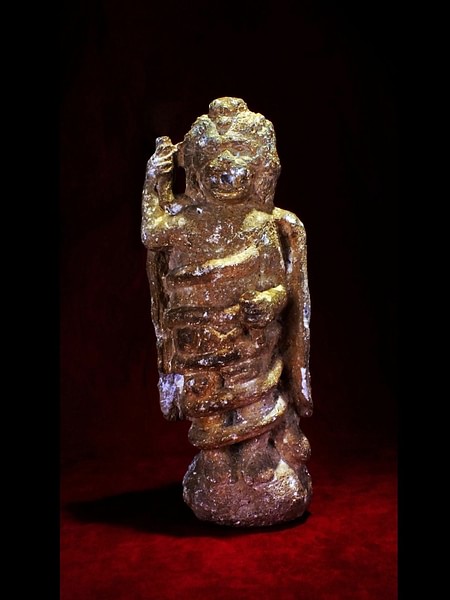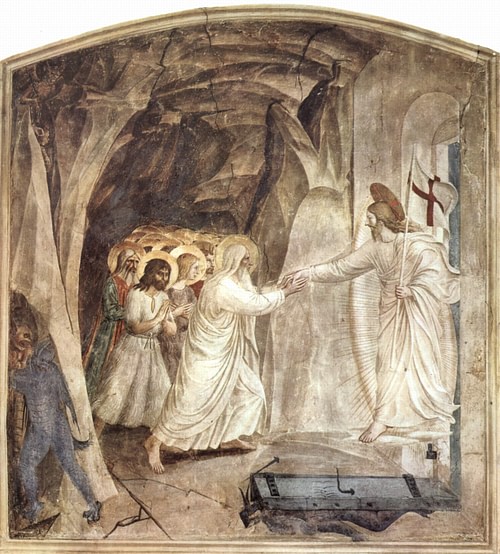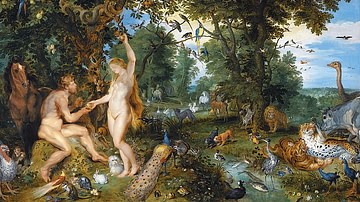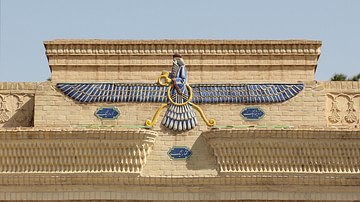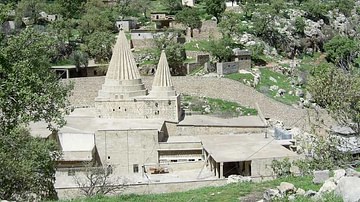Satan, or the Devil, is one of the best-known characters in the Western traditions of Judaism, Christianity, and Islam. Surprisingly, this entity was a late-comer in the ancient world. Satan, as a totally evil being, is nowhere to be found in the Jewish Bible. He evolved during the height of the Persian Achaemenid Empire (beginning c. 550 BCE) and was adopted by Jews living under Persian rule at the time. His formal name, Satan, derives from the Hebrew 'ha-Satan'. 'Ha' means 'the' and 'Satan' means 'opposer' or 'adversary'. The name described his eventual function as the opposer of God’s creation. Greek 'diabolos', English 'devil', meant 'accuser', 'slanderer', again describing his role. The concept of Satan emerged over time and in phases.
The Problem of the Existence of Evil
Evil has always existed. Humans encountered natural disasters (earthquakes, floods), wars with pillage and rape, disease, plagues, and infant mortality, man-made evil such as murders and theft, and of course, death. As the ancients constructed their religious systems, the existence of evil had to be explained and rationalized. Creation myths often designated a high god or a king of the gods, who controlled everything including the other gods as well as nature. In this capacity, they were responsible for both good and evil. The term to describe this ability is omnipotence (all-powerful). In Deuteronomy 28, God declares that he controls both prosperity and suffering. Many creation myths addressed how and why evil arose.
Genesis may be understood as a polemic against their neighbors, the ancient Mesopotamians. In the Mesopotamian creation myth, the Enuma Elish, the gods themselves are responsible for evil. They are capricious and chaotic and created humans simply as slaves to offer them sacrifices. The God of Israel is shown as the opposite; he is never capricious, there is a divine plan, and everything he created is deemed good. The narrative function of the 'fall' in the Garden of Eden, the story of Adam and Eve, was to demonstrate that evil began through the fault of humans, not God. Their disobedience led to man’s struggles to produce food and woman’s pain in childbirth. But the most severe punishment was the loss of their immortality. The sin of Adam and Eve brought on the greatest evil, death. As their descendants, we are all doomed to this fate.
Being human, people projected their own experiences upon the gods. Kings had courts of nobles and advisers. As on earth, so in the heavens. Like any court, there were higher and lower officials. The higher ones were the angels in Judaism. The lower deities, daemons (in Greek), were originally neutral but over time were blamed for evil.
In Genesis, God speaks to his court, "the sons of God", the angels, as he proceeds to create the earth. At the end of creation, we have a strange passage in Genesis 6. We read that "the sons of God" had intercourse with human women, producing the "Nephilim", ancient giants. The purpose of this narrative is to explain why God sent the flood (evil on the earth). Many pantheons had gods who mated with women, particularly Zeus in Greek mythology. Israelite tradition, however, rejected this behavior as this mixing could lead to the great sin of idolatry.
Ha-Satan & The Book of Job
The Book of Job (c. 600 BCE) is the earliest text to address the problem of theodicy, which is a modern term for the problem "If God is good, why does he permit evil and suffering to exist?" The book opens with the angels apparently reporting to God. Among them is the angel ha-Satan, whose function was to travel the world placing 'obstacles' (the meaning of his name) in front of humans, requiring them to make a choice (good or evil). In this role, we can say that he acts as God’s prosecuting attorney. Reporting back to God, he mentioned God’s servant Job, who had prospered. But, of course, he says, it is because God granted Job so much favor.
The bet is on. God tells ha-Satan to destroy all of Job’s prosperity, everything except his life. God is sure that Job will not turn away from him. Job’s children are killed, his crops and herds destroyed, and he suffers horrible diseases. Job’s friends all come to comfort him and convince him that he must have sinned because God is a god of justice. Throughout, Job insists that he never sinned; God has unfairly punished him. Frustrated, Job calls on God to explain, and a voice from the whirlwind admonishes him: "Where were you when I laid the earth's foundation?" (Job 38:4) In other words: 'How dare you (a mere mortal) question me?' Job is humbled and concedes the prerogatives and power of God.

Ha-Satan appears rarely in the Jewish scriptures. In the few references to ha-Satan, he opposes humans, not God. In Eden, the serpent serves this function, offering a choice to Adam and Eve. Throughout most of the books of the Prophets, evil is blamed on the people’s sin of idolatry. God is still in control punishing Israel.
Persian Rule & Zoroastrianism
When Jerusalem was conquered and destroyed by the Neo-Babylonian Empire (587 BCE), some Jews were taken into captivity in Babylon. Cyrus the Great then conquered the Babylonians in 550 BCE and established the Persian Empire. The state cult of Persia was Zoroastrianism, founded by the prophet Zoroaster. Evil was seen as the polar opposite of good. A pure, good being, Ahura Mazda ('Wise Lord') was the source of everything, and at the polar end was druj, chaos. Druj became personified as Angra Mainyu ('false', 'deception'), also known as Ahriman. The heavens, the earth, and all humans fall within this polar range.
Cyrus permitted the Jews to return to Jerusalem (539 BCE), although some stayed. They took many elements of ancient Persian religion with them, and they merged the personification of chaos with earlier views of ha-Satan. Now he was just Satan or, in Greek, diabolos, the Devil, and the Jews began assigning all evil to Satan instead of God.
The Dead Sea Scrolls
In the writings of the Jewish sect of Essenes who settled at Qumran (c. 150 BCE), we have our first literature that created a method known as the personification of evil. The sectarian literature equated Satan not only with evil but specifically with anyone or any group not in agreement with their own views, including other Jews. According to their texts, God had created two spirits in humans: the way of light and the way of darkness. The demons were now under the control of Satan; he sent them to possess those in darkness to commit evil. The Essenes applied symbolic names to Satan and his agents; Belial (Hebrew for 'worthless') who will lead the "sons of darkness" against those of light in the final battle (The War Scroll). As with the angels and archangels in heaven, we now have hierarchy and different functions in Satan’s court. Beelzebub was one of the seven princes of Hell and derived from an ancient Canaanite god who was known for getting rid of flies (carriers of disease). Thus, Beelzebub, Lord of the Flies.
Various apocalyptic texts were among the scrolls at Qumran. The Books of Enoch fill in more details about the "sons of God". They were condemned for teaching humans metallurgy and magic and were punished by being tossed out of heaven and chained in the abyss (the Jewish concept of Sheol, the land of the dead) for eternity.
In another text, Jubilees, more Devil lore was added. Satan’s name here is Mastema (which means 'hated' or 'hostility'). We learn that Mastema wanted to be higher than God and rebelled. He and his fellow angels were tossed down into the bottomless pit. Satan became the fallen angel. God wanted to destroy all the demons after the flood, but Mastema asked God to let him have a tenth of them to continue to plague men because "the evil of the sons of men is great" (10:8). With God’s permission, Mastema became the tempter who was written back into earlier stories. In Jubilees, it was Mastema who was permitted to test Abraham with the binding of Isaac. In other words, God’s omnipotence remains intact; Satan could not do his work without God’s permission.
The New Testament
In the letters of Paul and the gospels, we have the view that Satan is now the ruler of this world. This is expressed in a letter written by one of Paul’s disciples:
Put on the full armor of God, so that you can take your stand against the Devil’s schemes. For our struggle is not against flesh and blood, but against the rulers, against the authorities, against the powers of this dark world and against the spiritual forces of evil in the heavenly realms (Ephesians 6:11-12).
Paul often referred to the demons as the agents of Satan who interfered with his mission. Writing from prison, Paul explained that he could not visit his community "because Satan hindered us" (1 Thessalonians 2:17-18). Paul’s inner struggles were expressed in what can be understood as a form of possession: "And to keep me from being too elated ... a thorn was given me in the flesh, a messenger of Satan, to harass me ..." (2 Corinthians 12:7-9). Paul saw this as God’s ability to control Satan to test him. His familiar phrase, that believers now live in Christ, referred to Christ’s protection against the influence of Satan’s demons in the universe.
The Devil also looms large in the first gospel, Mark (c. 70 CE). Mark utilized a common stereotype to describe the ministry of Jesus, that of a charismatic exorcist who both preached and performed miracles throughout the Roman Empire. 'Charismatic' (Greek, 'gifts') is the claim that their abilities were a “gift from the gods.” An exorcist was someone who drove out demons. By the first century, physical and mental disabilities and diseases were understood as possession by demons. Mark emphasized the ministry as a battle between Jesus and the current rule of the Devil on earth.
At once the Spirit sent him out into the wilderness and he was in the wilderness forty days, being tempted by Satan. He was with the wild animals, and angels attended him. (Mark 1:12-13).
It is interesting that Mark did not have to explain the character of Satan; he assumed his readers knew. Both Matthew and Luke expanded this scene (Matthew 4:1-11; Luke 4:1-13). Satan, in his role as the tempter, presented Jesus with three temptations, but Jesus always knows the correct response from scripture. It is significant that Jesus does not dispute Satan’s claim to control the kingdoms of this world.
While Mark’s disciples are often confused over the identity of Jesus, all the demons know him and recognize his superiority. In Mark 5:1-13, the collective name of the demons being driven out by Jesus is "Legion", which may be Mark’s not too subtle view of the Roman army. Mark and the others presented the opponents of Jesus as under the influence of Satan. In Luke and John, Satan "entered into Judas" to betray Jesus (Luke 22:3). The culmination of blame for the death of Jesus reached its heights in John 8:40. In John’s gospel, the Jews can never achieve salvation because they are children of their "true father, the Devil".
The Book of Revelation (c. 90-100 CE) by John of Patmos is an apocalyptic vision of when God would intervene in human affairs in the final days and punish Rome for its persecution against Christians. He included the claim that Satan was chained in the pits of Hell so that he relied upon his agents for his work. The principal agent is referred to as 'the beast' and the 'deceiver'; the term 'anti-Christ' is not in Revelation, but in the three Johannine letters. The deceiver will appear as someone good and gather a world following. You will know his followers by the sign of '666' that they carry.
In one of John’s visions, he referenced Isaiah 14, a polemic against the king of Babylon. Isaiah castigated the king who titled himself "day-star" for his hubris of thinking he was divine: "How you have fallen from heaven, morning star, son of the dawn!" When Jerome translated the Hebrew scriptures into Latin in the 4th century CE, he knew that the Romans named their morning star - the planet Venus - Lucifer and translated the passage as such. Lucifer became the most popular name in the Middle Ages.
Throughout most of the book of Revelation, Satan remains chained in the pit. At the end of Christ’s 1000-year reign on earth, Satan is released for the final battle. The irony is found in the image of Christ "as a lamb" who nevertheless defeats this monster. He is tossed into the "lake of fire", the Dead Sea (Rev. 20:1-5).
The “Harrowing of Hell”
In the Acts of the Apostles, Luke claimed that Hades (Sheol) could not hold the crucified Christ (2:27). In 1 Peter 3, Jesus "made proclamation to the imprisoned spirits who disobeyed long ago" and 4:6 "the gospel was preached even to those who are now dead." By the 2nd century CE, details were added to the story of Jesus’ death to elucidate two details:
- What was Jesus doing in the interim between Good Friday and Easter Sunday?
- How could a righteous person of the past be saved if they had no opportunity to know Jesus?
While his body was in the grave, Jesus’ soul traveled to Hell where he battled Satan for the souls of the righteous. When the stone was rolled back, these righteous souls came with him (Adam, Noah, Moses, Plato, and Aristotle). The idea that Christ "descended into Hell [and] on the third day, he arose again" became embedded in the 4th-century CE Nicene Creed. By the early Middle Ages, the story was known as the Harrowing of Hell. The word, 'to harry' meant a raid or incursion, such as the Viking raids.
Characteristics of Satan & the Personification of Evil
Christian leaders in the 2nd century CE adopted the method of the personification of evil against Jews, women, heretics, and all things pagan. The native cults believed that the gods resided in their temples, but these were agents of Satan. The first iconic portraits of Satan came from the Greco-Roman fertility deity, Pan, who was half-man, half-goat. This is how Satan got his hooves and horns. Pan was represented with and was famous for a huge, erect phallus. This appendage became common in describing Satan. At first, drawn black, red became the standard color in his association with hellfire.
It was also in the 2nd century CE that both Christians and Jews - the early Rabbis - applied new understandings to the story of the fall. This is when the serpent became fully identified as the Devil in disguise and Eve took on more significance as the primary sinner in Eden. With misogynistic views of all women, Eve was understood to have been seduced by the serpent (because of that huge phallus), and then she seduced Adam. In the Rabbinic treatise, Genesis Rabbah, Eve’s sexual shame is why women remain veiled, and that menstruation was the punishment for shedding the blood of Adam. Tertullian, a 2nd-century CE Church Father, claimed that through Eve all women were the "Devil's gateway" and because of Eve "even the son of God had to die" (On the Apparel of Women, I).
The religious traditions of Europe (the Celts, Druidism, and Teutons) added other characteristics. The Celts had a horned god of the west, Cernunnos, similar to Pan. The daughter of Loki had a dual role in fertility as well as rule over the dead, and her name became incorporated to the place 'Hel' or Hell.
With animal characteristics, Lucifer and his demons had the ability to change shape, and so a constant watch was necessary. One could trick Lucifer and repel him with signs of the cross, holy water, the rosary, and communion wafers. Based upon feudal relationships, the concept of a pact arose in selling your soul to Lucifer in return for prosperity (the famous story of Faust). Only the intervention of Mary, the mother of Christ, could break the pact. This is when exorcism rituals were developed that are still taught to certain Catholic priests.
Dante Alighieri’s (1265-1321 CE) Inferno depicted Satan as a three-faced monster in the lowest section of Hell (ice, the furthest from the light), with giant bat-wings. For Dante, the greatest sin was betrayal, and Satan consumes Brutus, Cassius, and, of course, Judas.


